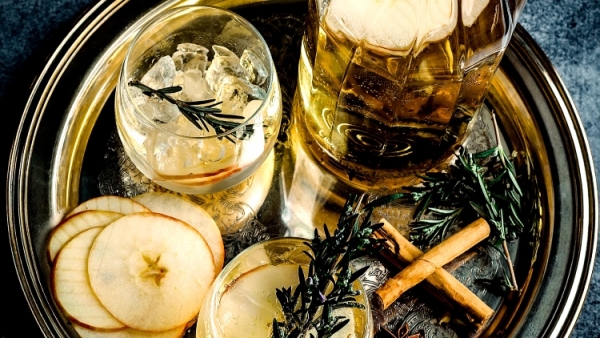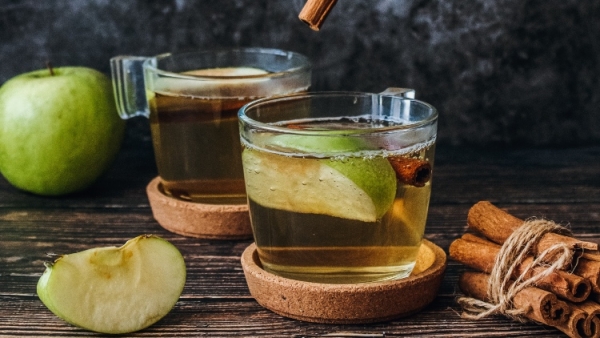A second bite: how to grow your autumn and winter cider pickings?

Arguably there’s little contesting that summer is the apple of the cider drinker’s eye, but operators should be aware that autumn and winter sales don’t completely pale in comparison.
ADVERTISEMENT
Brothers' autumn and winter drinks
As we enter the cooler months and approach the festive season, we can expect to see consumers start to look for more warming serves in the on-trade. Traditionally mulled wine has been a firm favourite amongst consumers; however, we are beginning to see a trend towards alternatives and twists on traditional drinks, such as mulled cider, as consumers explore the category.
Mulled cider is a simple yet impactful way to create a sense of occasion during the winter months, helping consumers celebrate from Halloween through to Christmas and New Year’s Eve.
This year we expect the trend towards mulled cider to continue and at Brothers we have a broad range of exciting innovative flavours that be used to create delicious yet simple seasonal serves.
Perfect for Halloween, Toffee Apple remains a cider staple, offering smouldering toffee and cream soda flavours – simply warm through and add cinnamon sticks to create our Spiced Toffee Apple Winter Warmer for an interesting twist on a traditional mulled cider. This serve is easy to make in large quantities and gives operators a way to offer up something that guests may not have tried before.
Another great twist on a classic winter favourite is our hot toffee apple toddy recipe. Simply serve Brothers Toffee Apple cider with a kick of spiced rum and cinnamon and add clementines and cloves to finish.
With many autumn and winter celebrations coming up including Bonfire Night, Halloween and Christmas, there are lots of opportunities to drive that sense of occasion with your drink’s menu.
With the changes around table service within the on-trade, ensure your menu is easy to access and navigate with your additional serves included. Keeping the mulled cider on the bar and visible from the tables can create a bit of atmosphere – as well as a wonderful festive aroma.
According to CGA data, while last summer’s on-trade cider pickings stood at £738.8m, combined autumn and winter cider sales totalled a fruitful £836.7m.
Additionally, more than 163m pints (928,981 HL) of draught cider were poured in pubs during autumn and winter last year compared to 142m (810,456 HL) in summer alone.
Though cider expert and founder of the Discover Cider campaign, Gabe Cook, acknowledges the “well-known fact” that cider is seen as a summertime drink by consumers, he remains puzzled by cider’s struggle to transcend seasons and temperature in the same way lager does.
“Nothing slakes the thirst on a warm summer's day like a fresh, crisp, cold cider,” Cook tells The Morning Advertiser (MA). “But it is a real challenge for cider makers that, come the autumn, cider sales drop off a cliff.
“This mystifies me to a point,” he continues. “Lager, a similarly refreshing pint, doesn't undergo any near as big a drop during the colder seasons than cider does.
“There is a lot of work to do to try and enable consumers to enjoy all different styles of cider appropriate to different times of year.”
Love of cider re-ignited
Unfortunately for pubs, the small matter of a global pandemic upset this summer’s applecart with the seasonal cider love-in passing with drinkers behind closed doors until 4 July and hampered by trading restrictions since.
However, according to Rob Sandall, on-trade sales director at Thatchers Cider, pub goers became increasingly sweet on cider in exile, offering a potentially lucrative post-lockdown harvest for operators as customers grow more confident in returning to pubs during autumn and winter.
“We definitely witnessed the British public re-ignite its love of cider during their at-home lockdown experiences,” he explained.
“With the wide choice of drinks on the supermarket shelves, we saw over 1.1m new shoppers re-enter the cider category during lockdown.”
He adds pubs now have “a fantastic opportunity” to provide the ciders drinkers enjoyed over lockdown to returning customers eager to experiment and try fresh styles.
“Shoppers have been opting for brands that are vibrant, new and exciting, they are favouring British brands they trust where great taste is assured,” he continues.
“The importance of provenance and authenticity has never been so important in a world where people want reassurance.”
Less but better
As part of the gravitation towards provenance and authenticity, Sandall adds that consumers increasingly plumped for premium ciders during lockdown.
“According to CGA Brandtrack, 43% of people said they’ll continue to drink the premium brands they enjoyed during lockdown, another opportunity for pubs to review their offer and restock according to the new normal that’s now with us,” he tells The MA.
CGA research also found that roughly a third of all draught and packaged ciders sold in the on-trade are now premium varieties – with summer’s 33% slice pipping the 30% yielded by autumn and winter sales.
Alistair Morrell, CEO of trade alliance Cider is Wine – which has attempted to educate both consumers and trade executives about 100% apple and pear ciders since 2018 – stresses that quality is becoming increasingly more important than quantity adding that strong brand stories can lure drinkers back to pubs and bars post-lockdown.
“This is a long-term trend which describes how millennials and Generation Z are trending,” he explains. “There is consistent downward pressure on volume drinks, and little understanding in the trade that ciders are low price because the law only requires the use of 35% juice, all of which can come from concentrate and can be imported.
“As consumers seek more authentic, provenance-led, genuine artisan drinks the focus and profiling on ciders and perries fermented exclusively from apples and pears, not-from-concentrate, is required so that we can bring local delight to customers and help a previously strong British heritage industry.”
Morrell adds that if operators are to coax consumers back into hospitality they must “surprise and delight” in order to retain them.
“For example, ciders and perries – authentically made from 100% juice – served as wine are excellent lunchtime and informal drinking opportunities, because they have half the alcohol of a bottle of wine.
“Put the suggestion out there and own the idea - the right consumers love it.”
ADVERTISEMENT
Creating a cider range to work hardest for you at the bar
There’s no more important time to make sure the cider range you have on the bar works as hard as you do. The British public has re-ignited its love of cider with brands they enjoyed during their at-home lockdown experience. Keen to find these again when returning to the pub, ensure your cider list features the brands your customers are asking for.
Provenance and authenticity are so important in today’s new world where people seek reassurance and a connection with the premium brands they trust.
Great tasting ciders on your bar will please your customers and work hard for you. More drinkers than ever are turning to Thatchers with its premium credentials. It has the loyalty of its drinkers, and importantly, the best rate of sale of any draught cider.
Over the summer, as shoppers had their choice of drinks on supermarket shelves, Thatchers delivered the fastest cider growth at +61.8% volume to become the UK’s no 2 cidermaker. Thatchers Gold delivered the largest cider volume of any brand in the last 12 months.
So which ciders should you choose? Having quick recall brands that customers know and trust is essential to avoid slow-moving lines on the bar.
- Thatchers Gold will be welcomed by your customers and should be your number one choice of apple cider. With its refreshing appley taste, if you’re only able to stock one apple cider, go for Thatchers Gold.
- If you stock two, then have the UK’s number one cloudy cider, Thatchers Haze, alongside for a top performing pairing to broaden appeal to both drier and sweeter tastes. Bars with Gold and Haze sell 75% more cider than when Gold is paired with other ciders.
- Thatchers Rosé is now available on draught. This follows consistently strong off trade sales, with +246% growth in the last 12 months.
- Appealing to the growing number of people looking to moderate, include Thatchers Zero in your fridge, a must-stock for your alcohol-free range.
Contact us for more information at 01934 822862
Bobbing for new trends
While post-lockdown customers initially craved comfort and normality in pubs – meaning they often plumped for classic brands and experimented less – Cook argues that now pubs have been open for a while nostalgia for classic brands is making way for curiosity.
“There is a whole tranche of drinkers who are constantly looking for the next interesting trend, but they need the opportunity to experiment and sample,” he explains. “This is where having a 'craft keg' or well cellared bag in box cider could come to the fore.”
With this in mind, Cook suggests that this autumn and winter could be an ideal opportunity to challenge the perception that cider is purely a summertime thirst quencher – arguing that grouping summer cider serves and winter tipples is like comparing apples to oranges.
“This is just one type of cider,” he explains. “There is, in fact, a multitude of styles, incorporating more bold and earthy characters that would line up better with maltier ales than crisp lagers.
“So, as well as classic refreshing cider, I would complement these by seeking out ciders that have bolder, tannic characters and that don't rely on being super chilled.”
Susanna Forbes, a cider expert, author and co-founder of Little Pomona, echoes Cook, stating: “Anecdotally I heard that during lockdown, consumers had become more willing to experiment.
“They had to seek out good cider anyway, so now their horizons have widened, they want to keep exploring.
“So there is a big opportunity for go-ahead publicans and restaurateurs to feed that sense of exploration and excitement.
“People have definitely got more interested in ‘local’ and cider fits into that bracket.”
Apple still core
However, with more than half (55%) of the 122 new cider products introduced to the drinks market in 2019 still apple-based - compared to 39% fruit ciders - according to CGA, it’s vital that any cider range has a traditional core.
“At the one end of the cider spectrum, flavoured ciders continue their grip on the taps and in the fridge,” Cook explains. “At the other end however, is an increase in the number of brands that display more 'craft', 'artisan' or purely 'indie' credentials.
“These are ciders that put the apple at the forefront, often with a description of the varieties and processes used.
“This was beginning to come to the fore in keg, as a second tap offering to the ubiquitous mainstream brands available in all pubs.”
Crunching CGA’s numbers reveals that while the slice of last summer’s cider sales stemming from apple variants stood at 58%, a juicy 62% of Autumn cider sales and 61% of winter pints poured come from apple variants.
New or trendy flavours
However, despite the need for a polished apple cider offer, Nicola Randall, senior marketing manager at Brothers Drinks, adds that cidermakers have continued to pique the interest of consumers with innovative new flavours.
“This demand is particularly prevalent amongst the younger generations, and a trend that we saw pre-lockdown and most certainly expect to continue,” she tells The MA.
“In a survey conducted in 2019, 58% of Generation Z and millennials said they typically choose ‘unusual, new or trendy flavours’, and with this demographic most likely to go out into the trade, operators should ensure they cater to their tastes and capitalise on sales with the right range of fruit ciders.
Randall adds that lockdown appears to have both accelerated this trend and fuelled further demand for new and unusual pours.
“This was reflected in our off-trade performance as we experienced above expected growth in sales across our ‘Curious Mix’ range, our leading SKUs Toffee Apple and Rhubarb & Custard performed extremely well, with Toffee Apple reported 22.2% up in value in recent months as well as Rhubarb & Custard up 62%,” she explains.
“Our ‘Curious Mix’ range is crafted to stoke intrigue amongst consumers and its success highlights how consumers were looking to explore flavours during the lockdown period.
“As customers return to the on-trade, we would recommend for operators to provide a range of ciders on their menu that taps into this trend for exploration.”
Warming winter serves
With many autumn and winter celebrations including Bonfire Night, Halloween and Christmas approaching, operators can expect to see consumers start to pick out more warming on-trade serves, Randall adds.
“Traditionally mulled wine has been a firm favourite amongst consumers, however we are beginning to see a trend towards alternatives and twists on traditional drinks, such as mulled cider, as consumers explore the category,” she explains.
“Mulled cider is a simple yet impactful way to create a sense of occasion during the winter months, helping consumers celebrate from Halloween through to Christmas and New Year’s Eve.”
This year, Randall expects the trend towards mulled cider to bloom post-lockdown, with Brothers having already prepared a number of seasonal serves in anticipation.
“Perfect for Halloween, Toffee Apple remains a cider staple, offering smouldering toffee and cream soda flavours – simply warm through and add cinnamon sticks to create our Spiced Toffee Apple Winter Warmer for an interesting twist on a traditional mulled cider,” she says.
“This serve is easy to make in large quantities and gives operators a way to offer up something that guests may not have tried before.
“Another great twist on a classic winter favourite is our hot toffee apple toddy recipe. Simply serve Brothers Toffee Apple cider with a kick of spiced rum and cinnamon and add clementines and cloves to finish.”
Low and no serve popularity
According to research from Mintel in November 2018, more than three quarters (78%) of 18 to 35-year-olds are conscious of the calories in alcohol they drink and are looking for alternatives – an increase from 30% in 2012.
According to Sandall, this trend has spilled over into the cider category.
“Whether that is from the perspective of healthy living, moderation, or indeed if you’re the designated driver, customers are now expecting pubs to offer a good quality low/no range of beers and ciders,” he explains.
“There are some great quality alcohol free drinks available now, such as our Thatchers Zero, which is made from bittersweet apples from our West Country orchards, so really hits the mark not just for those who are moderating, but those who are looking for a great tasting, appley cider that really does taste of cider.”
Picture credit: Bill Bradshaw
Educate yourself
However, Forbes underlines that if pub operators are serious about their cider offer, it’s crucial that they underpin it with extensive product knowledge.
“Look up DiscoverCider.com, the 40-strong cider producer group,” she recommends. “Do you have a producer near you? If so, call them up, and see if you can visit.
“If you're near London, reach out to Hawkes. Go and visit and see how it's all crafted. If you're in the South or the West, Wales or the East Midlands, contact the regional cider association to see where you can go. Tune into the Campaign for Real Ale’s marvellous Learn & Discover platform, and find out about orchards, apples, cider making.”
Forbes suggests that operators should aim for two keg cider lines supplemented by a bushel of bottled pours. “One with the ‘regular’, the other with either a local cider or one of the new-style keg-conditioned key kegs,” she explains.
“Build a small array of bottled ciders and perries, and write a menu, complete with tasting notes. Pitch these like lower abv wines, and serve by the glass, in wine glasses.
“Offer flights of cider, so people can try different ciders. Three 100ml serves works really well in our Tasting Room.
“If you serve food, test out the ciders and perries with your dishes, and offer some menu matches.”













